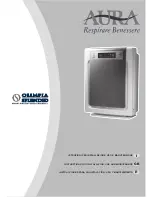
16
Delay Profile
The delay profile controls the start-up and shut-down
characteristics of the packaged heat pump unit. By varying
the start-up and shut-down characteristics of the packaged
heat pump unit, the system can be optimized for energy
efficiency, humidity control, and comfort.
The delay profile has a two-step ON delay. The blower will
begin operation at 31% airflow for 30 seconds. The second
step operation is 75% airflow for 30 seconds. After the two-
step ON delay has been completed, the blower operation
will be 100% until the thermostat has been satisfied. There
is also a 60 second OFF delay at 50% airflow.
Demand Defrost Control
The demand defrost board controls the defrost cycle in
response to ambient temperature, outdoor coil temperature
and accumulated compressor run time. The heat pump is
allowed to operate in the heating mode until the combination
of outdoor ambient and outdoor coil temperatures indicate
that defrosting is necessary, based on the programmed
defrost curve. There are four preprogrammed defrost
curves on the board.
• A jumper pin is used to switch between the different
curves. The default setting is program two and is the
recommended setting for most standard applications.
See Table 5 (page 17) for additional defrost curves
settings.
• The factory default setting includes a 30 second
compressor delay function with a 40 ° F defrost terminate
temperature. If additional defrost time is needed, a higher
terminate temperature is available by selecting a different
demand curve.
NOTE:
The 30 second compressor delay
function is optional and based on the demand curve
selected.
• The standard defrost cycle will terminate after 13 minutes
and 39 seconds or when the coil temperature reaches
its terminate temperature, whichever occurs first.
• The defrost board is equipped with a 5 minute Anti-Short
Cycle Delay (ASCD). The compressor will not turn on
until it reaches the minimum 5 minute off time.
• The control contains a forced - defrost feature, which
places the system into defrost mode every 6 hours and
4 minutes, unless the coil temperature is above the
selected terminate temperature.
• The system can be manually forced into defrost mode at
any time by shorting the
TEST
terminals on the demand
defrost board together for more than 9 seconds. The
coil temperature sensor does not need to be cold when
the unit is forced into defrost. After the
TEST
input is
removed, the defrost mode will terminate in 13.7 minutes,
if the coil temperature is above the terminate set-point,
or when the
Y
input is removed, whichever occurs first.
NOTE:
If a demand curve is selected which has a 30
second compressor time delay in defrost, the delay is
reduced to 10 seconds in TEST mode.
Ambient Sensor Mounting
For optimum performance of the heat pump system, the
ambient sensor must be mounted on the outside of the
unit. See Figure 7 (page 17).
1. Remove the mounting bracket wire tied to the control
bracket and all hardware included in the packet.
2. Remove star bushing from 7/8” hole in corner panel
of the unit. See Figure 8 (page 17).
3. Route the ambient sensor through the 7/8” hole in the
corner panel of the unit, and then through the 7/8” hole
in the mounting bracket.
4. Route the sensor through the star bushing. Use the
star bushing to secure the mounting bracket to the unit.
5. Secure the ambient sensor inside the plastic clip and
secure it to the mounting bracket with the screw and
nut provided.
6. Install one spacer nut between the plastic clip and
mounting bracket.
7. Bend the mounting bracket into position and screw the
mounting bracket to the corner panel.
Optional Comfort Alert
TM
Diagnostics Module
The Comfort Alert
TM
Diagnostics Module is a breakthrough
innovation for troubleshooting heat pump and air
conditioning system failures. The module installs easily in
the electrical box of the outdoor unit near the compressor
contactor. By monitoring and analyzing data from the
Optional Humidistat
An optional humidistat may be installed in the return
air duct for humidity control (when needed), maximum
system capacity and energy efficiency. The humidistat
senses when humidity in the return air stream is above
a preset level and sends a signal to the motor to reduce
airflow. This allows more moisture to be removed until the
humidity level drops.
NOTE:
The packaged heat pump unit is pre-programmed
for humidistat operation. Remove the jumper connector
between the two terminals marked
HUM
on the variable
speed board.
Install the humidistat in the return air duct as directed in
the installation instructions included with the kit. Wire the
humidistat through the low-voltage wire entrance in the
packaged heat pump unit to the quick-connect terminals
marked
HUM
. Wire the humidistat to open on rise in
humidity.
CAUTION:
To avoid personal injury or property damage,
make certain that the motor leads cannot
come into contact with any uninsulated metal
components of the unit.
Check all factory wiring to the units wiring diagram. Inspect
the factory wiring connections to be sure none loosened
during shipping or installation.
















































